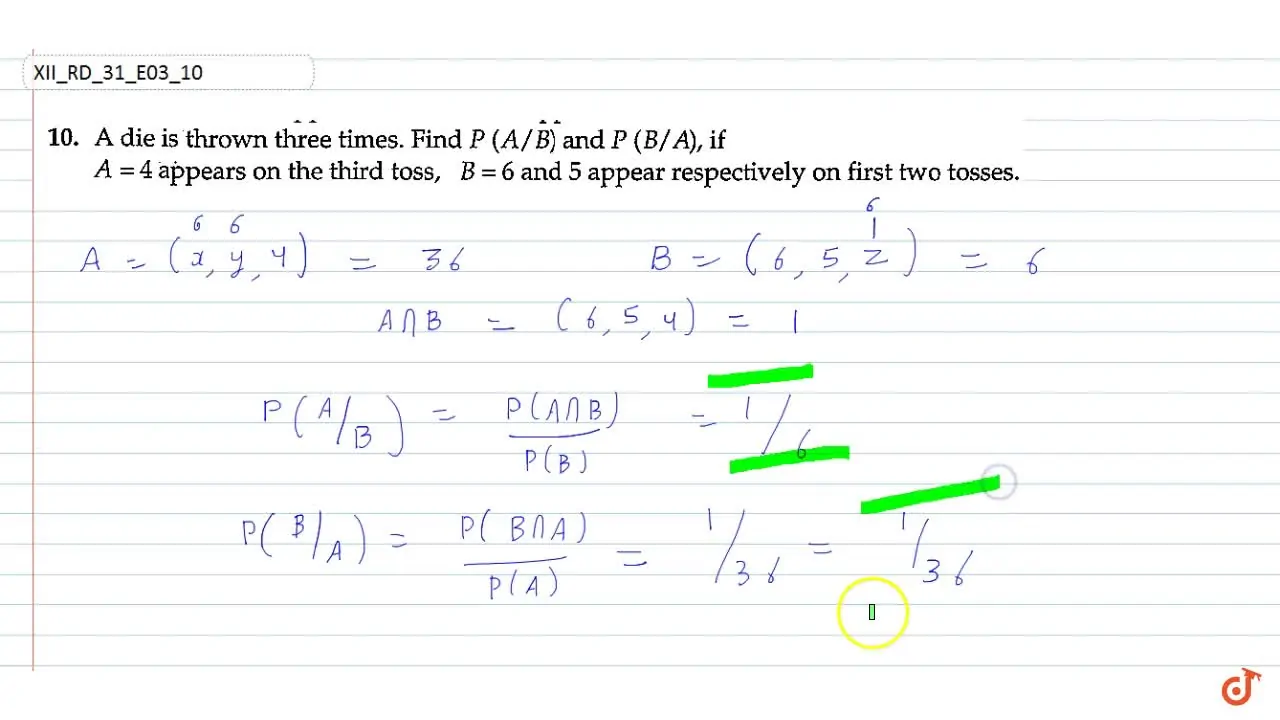A die is thrown three times. Find P(A/B) and P(B/A), if A=4 appears on the third toss, B=6 and 5 appear respectively on first two tosses.
We have,
A={(1,1,4),(1,2,4),(1,3,4),(1,4,4),(1,5,4),(1,6,4),(2,1,4),
(2,2,4),(2,3,4),(2,4,4),(2,5,4),(2,6,4),(3,1,4),(3,2,4),(3,3,4),
(3,4,4),(3,5,4),(3,6,4),(4,1,4),(4,2,4),(4,3,4),(4,4,4),(4,5,4),
(4,6,4),(5,1,4),(5,2,4),(5,3,4),(5,4,4),(5,5,4),(5,6,4),(6,1,4),
(6,2,4),(6,3,4),(6,4,4),(6,5,4),(6,6,4)}
B={(6,5,1),(6.5,2),(6.5,3),(6.5,4),(6.5,5),(6.5,6)}
We observe that
n(A)=36,n(B)=6 and n(A∩B)=1
∴P(A∩B)=1216,P(A)=36216=16
and P(B)=62160=136
Hence, P(AB)=P(A∩B)P(B)=13616=16
P(BA)=P(A∩B)P(A)=1216136=16
Related Playlists
Similar Questions
A die is thrown three times. Find P(A/B) and P(B/A), if A=4 appears on the third toss, B=6 and 5 appear respectively on first two tosses.
View SolutionA die is thrown three times, find the probability that 4 appears on the third toss if it is given that 6 and 5 appear respectively on first two tosses.
View SolutionDetermine P (E|F) in :A die is thrown three times,E : 4 appears on the third toss, F: 6 and 5 appears respectively on first two tosses
View SolutionA coin is tossed three times. Find P(AB) in each of the following: A= Head on third toss, B= Head on first two tosses A= At least two head, B= At most two heads. A= At most two tails, B= At least one tail.
View SolutionA coin is tossed three times. Find P(E/F) in each of the following: (i) E= Head on the third toss, F= Heads on first two tosses (ii) E= At least two heads, F= At most two heads (iii) E= At most two tails, F= At least one tail
View SolutionA die is thrown three times events A and B are defined as below: A= Getting 4 on third die, B= Getting 6 on the first and 5 on the second throw Find the probability of A given that B has already occurred.
View SolutionA die is thrown three times. Events A and B are defined as follows: A: 4 on the third throw, B: 6 on the first and 5 on the second throw. Find the probability of A given that B has already occurred.
View SolutionA die is thrown three times. Events A and B are defined as below:A : 4 on the third throwB : 6 on the first and 5 on the second throwFind the probability of A given that B has already occurred.
View SolutionA die is thrown two times and the sum of the scores appearing on the die is observed to be a multiple of 4. Then the conditional probability that the score 4 has appeared atleast once is:
View SolutionTwo dice are thrown. Find the probability that the sum is 8 or greater than 8, if 4 appears on the first die.
View Solution


